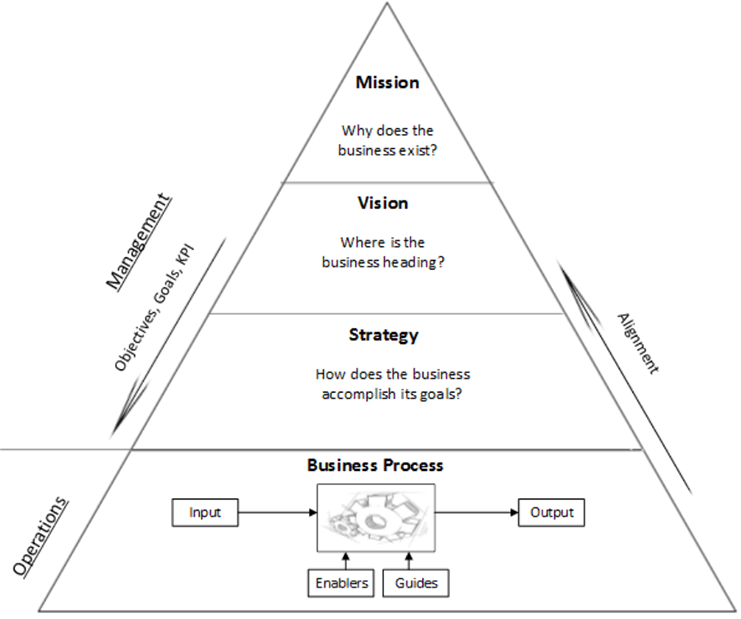Organizations have a vision statement for a reason – to communicate the direction in which they are heading and the goal (vision) they wish to achieve.
Visions are powerful tools that inspire people into action. A team that has a clear vision for their work will be more motivated to contribute to the process because they understand how their contribution fits in the grand scheme of things and helps move the needle in the right direction.
But it isn’t enough to simply have a vision, the vision itself will only get you so far.
A powerful vision paired with an inspiring visionary leader is the organizational gold at the end of the rainbow. The role of a visionary leader is an important one but it isn’t as simple as finding someone with a vision and giving them a position in your organization. Visionary leaders, while inspiring and essential, come with quirks and tendencies that will require some mitigation to ensure they are as effective as possible.

What is Visionary Leadership?
One of the best and most recognized examples of a visionary leader is Nelson Mandela. It was his vision that not only pushed for profound changes in his home country but also inspired the world. His words and quotes are recognized around the globe and there is no arguing his impact that we are still feeling to this day.
No, you do not need to have the reach of Nelson Mandela or even be a CEO to be considered a visionary leader, only the attention of a dedicated team that believes in the vision you are presenting – big or small. Here are some key qualities of a visionary leader:
They Inspire Those Around Them
It isn’t hard to spot a visionary leader but it is hard to resist being pulled into their orbit. Visionary leaders have a way of drawing people in and inspiring them to work towards a common goal. Their style is such that they tend to gather a team of passionate individuals, rallying them for a cause that seems so close they can taste it!
They are Great Communicators
Visionary leaders prioritize communication. Their role is to create a vision that inspires people to actually make it happen and they can only do that if they can effectively communicate with the team. They are inclusive because they understand the value of a number of perspectives and know that each person has something to add.
They are Optimistic and Enthusiastic
They are big picture thinkers whose optimistic charm is contagious. They believe in their vision with an unmatched passion driven by the sincere belief that it can and will happen (with the help of a team of course). This enthusiasm is responsible for the magnetic pull that seems to accompany every good visionary.
They are Open-Minded and Empathetic
A vision does not come without its challenges and being open-minded and willing to pivot when there is new information is important. Pairing nicely with an open mind is the ability to be empathetic, visionaries are able to connect with the team at a level that fosters a reciprocating relationship of trust and understanding.
They Embrace Innovation and Set Goals
A vision (by definition) is innovative because it has yet to be achieved… keyword being yet. Visionaries recognize the importance of setting tangible goals, communicating them to the team, and ensuring that there are rewards for achieving them to keep people motivated and pushing ahead.

Other Leadership Styles
For context, it is important to understand that there are a number of leadership styles, the visionary being one of the 6 that are most recognized. We can thank Daniel Goleman for artfully laying out the different leadership styles in his book Leadership That Gets Results. While this article will focus on the visionary leadership style, know that each style has its advantages and disadvantages and all provide value to a team.
Coaching
If you have ever played any organized sports, this will be a familiar style to you. Much like an athletic coach, leaders that implement this style tend to be supportive and helpful and create the ideal environment for high performers. One of the main characteristics that you will observe in this style of leadership is a culture of empowerment. These types of leaders value constant and incremental improvement, good ones will be able to recognize and respect individual boundaries and apply the right amount of pressure when needed.
Affiliative
Affiliative leaders focus on building relationships and camaraderie. They lead with empathy and understanding which helps the team realize that they are in it together and are motivated because they feel understood and seen. In essence, affiliative leaders put people first and are especially effective in stressful work environments, helping people push through tough times because they feel supported and valued. Affiliative leaders tend to struggle when it comes to giving negative feedback though because of the value they place on relationships.
Democratic
Democratic leaders see their job as a numbers game, gathering input and feedback to find the most agreed-upon solution. They tend to value creativity and have no problem taking more time to ensure that the best solution is reached. Consensus is important to democratic leaders, they trust their team and foster an environment where they feel safe to contribute their thoughts and ideas. Things may not move as fast under this type of leader but everyone will have the opportunity to have their say.
Pacesetter
Unlike the slow and steady democratic leader, pacesetting leaders are driven by results and the need to move up… fast! To work under a pacesetter, you must be self-motivated and driven because the expectations and the stakes are high. If you are a pacesetter, it is important to recognize that there is a slippery slope between being driven and driving over others. There are admirable qualities of this type of leader but they can be intimidating to those that don’t share the same style.
Commanding
Though often seen in a negative light, commanding leaders are particularly effective in situations where quick decisions need to be made. They work well under pressure and have no problem with confrontation when needed. This type of leader does not work well in all work environments and can quickly become problematic if respect hasn’t yet been established.

Developing as a Visionary Leader
Whether you are a natural visionary or are looking to become one, it is important to consider the following aspects of development to ensure that all pieces are in place to properly develop as a visionary leader:
Industry Knowledge
Having industry knowledge may seem obvious but it is incredibly important for a visionary, no rock is to be left unturned as they gain familiarity with every component of the organization and the industry in which it resides. Understanding the trends, best practices, and key players in the industry will better inform the viability of the vision – visionaries are optimistic, not blind.
Develop Outside Perspective
Being able to step outside of your organization and view it from a different perspective is one of the key traits of a visionary leader. While everyone else is busy hustling, visionaries are taking the time to observe the intricacies of the full machine that is the organization. This practice can serve to better inform internal workings by offering insight into how the business is perceived from the outside. Some of the best innovations come from taking a step back.
Cultivate Relationships
Visionaries are often likable by nature but that also comes with their ability to develop and cultivate relationships. The bigger the vision, the more resources and people are needed to make it happen. Visionaries are generous, often giving credit to their circle of colleagues and other acquaintances. They understand that, though they may see a more complete picture than most, they cannot possibly know everything so they rely heavily on the networks they create to fill in the blanks.
Connect Ideas and Opportunities
Much like the perks of looking at the organization from the outside, stepping back far enough to see ideas and people worth connecting is just another example of the great value that visionaries bring to the table. Being able to leverage all the resources available is not only cost-effective but also creates an environment for innovation to thrive where it might otherwise be stifled by arbitrary boundaries between departments or organizational hierarchies.

Quiet Time for Brain Exercise
Your brain is like a muscle, use it or lose it. While it’s easy to see the energy needed to perform a physically demanding job, brainwork often appears to be invisible and sometimes underappreciated. Don’t be fooled, being a visionary is a mentally demanding job. It is important that visionaries set appropriate boundaries on their time and attention and make those boundaries clear to the team. Some visionaries require quiet time in a distraction-free environment to hash out their plans, grant them this and any other accommodation that may be needed so that they may exercise their brain in peace.
Regular Vision Tests
Visionaries tend to have such strong convictions and faith in their visions, not from blind optimism but because their ideas are routinely tested against other visions and informed by outside expertise. They are always consulting with trusted colleagues and industry leaders, observing early adopters of similar ideas and asking themselves “what if…” in an attempt to refine their vision to be foolproof. Part of this testing happens naturally as visionaries consume more and more information relevant to their industry and apply their learnings in practical ways that better inform and refine the vision.
Practice Communication
No one can build excitement quite like a charismatic visionary but that doesn’t always come easy. Some visionaries get lost in their own excitement and implement a just-trust-me kind of attitude which can backfire when others cannot see what all the fuss is about. Clearly communicating the vision not only helps others understand it but helps them understand their place in the process so that they can better support its development. When a team feels ownership over an idea, they are instantly more motivated to see it come to life.
Take Calculated Risks
There are no gains without any risk. It is important to understand the level of risk that an organization is willing to undertake for the sake of a vision as some companies are inherently risk-averse. Visionaries, when left unchecked, can become a huge liability to the organization but they can also be the best thing to ever happen to them.

Examples of Visionary Leaders
We already mentioned Nelson Mandela as one of the most recognizable and obvious visionary leaders. In order to fully understand the impact of visionary leaders on your everyday life, here are an additional 5 that you may (or should) recognize for the impact of their visions on the global community.
Salman Khan
You may not recognize his name at first but, especially if you are a parent, you are likely familiar with the impressive platform that he built called Khan Academy. Khan Academy is a non-profit that offers free educational videos and tutorials online that are available around the world. Salman had a vision that was inspired by his time spent tutoring his younger cousins, he wanted tutors and educational resources to be available to every young person, not just those with money. His mission and vision?
“Free world-class education for anyone, anywhere”
Simple, right? While initially focused on younger learners, the platform has expanded to higher levels of education to reach even more people.
Bill and Melinda Gates
Unless you live under a rock, you have heard of the Gates. While Microsoft may be the first thing that comes to mind, it is the Bill and Melinda Gates Foundation that offers an even better example of visionary leadership.
Together, they are “working toward a world where every person has an opportunity to lead a healthy, productive life—a vision that is as important in our home state as it is around the globe.”
The foundation holds the title of the largest charitable organization in the world. At the time of writing this blog, Bill Gates is the fifth richest person in the world so it is comforting to see all that money go to good use and towards a vision that truly inspires and reaches people in every corner of the world.
Maya Angelou
Another household name, Maya Angelou is a one-woman show! She wrote poetry and books, acted, danced, and sang. She was the recipient of countless awards, some after her death in 2014. She also holds more than 50 honorary degrees!
Arguably, one of her most impressive accomplishments was her civil rights activism. Dr. Angelou worked closely with other recognized civil rights leaders like Martin Luther King Jr. and Malcolm X to fight for equality in the ’60s for African-Americans and the fight is ongoing today.
Very recently, she even became the first black woman to be featured on a U.S. coin!
Her many works and her inspiring words will stay with us for generations to come as her vision lives on in anyone who continues her work towards a vision of a more equitable world.
Malala Yousafzai
The world knows and loves this brave young woman. She believed so strongly that girls should have access to education that, contrary to local rules, she boarded the school bus in an attempt to go to school. Because of her defiance, she was shot in the head by the Taliban.
She was 15 years old.
In the western world, it is hard to imagine that our children would ever be in a situation where they would have to risk their lives for an education and we take for granted that this is not the reality for so many young people. Malala opened our eyes to this injustice.
Not only did she survive, but her vision for education and human rights for girls was made even stronger and quickly spread around the world, her bravery won her the Nobel Peace Prize. Malala inspired a whole generation of girls to push for the right to education and disrupt the system of oppression that weighed so heavily on her peers and girls around the world.
Dr. Pamela Palmater
While not known around the world like Maya, Bill, or Malala, Dr. Palmater has made strides in her home country of Turtle Island – also known as Canada to settlers. She is a Mi’kmaw citizen originally from Eel River Bar First Nation in New Brunswick.
Her vision is clear: an equitable world where Indigenous people are respected and valued for their traditional knowledge and wisdom. She pushes this vision by holding some pretty impressive positions as both a lawyer and a professor at one of Canada’s top educational institutes, Ryerson University, where she teaches Indigenous Governance.
Her list of recognitions and awards is a mile long but one of her most recognized contributions was her involvement in the Idle No More movement, a movement related to environmental and Indigenous rights. Because of her passion for justice, it is no surprise that she uses her position and her extensive education to push other social justice issues like that of murdered and missing Indigenous women and girls.
These are just a handful of examples of inspiring visionaries leaders and their accomplishments that changed the world but the pattern is clear – visionaries hyper-focus on their vision and work tirelessly towards it.

Benefits of Visionary Leadership
It isn’t hard to see the benefits of having a visionary leader in your organization or on your team. This optimistic and energetic individual has a way of inspiring those around them, motivating them to take up the cause and eagerly follow. Some key benefits of recruiting or fostering a visionary leader include:
Directional Hyperfocus
Visionaries have a way of always bringing it back to the main vision, ensuring that everyone is on track and heading in the right direction. Small bumps in the road are no match for their persistence and desire for the vision to come to fruition. These long-term thinkers pair well with the short-term and day-to-day team members that implement the work needed to achieve the vision.
Comfortable with Risk
When there is something worth striving for, risks are part of the game. Visionaries are more likely to take calculated risks because they can see the bigger picture and therefore more accurately understand not only the cost but the potential gain. Their optimistic nature also helps calm the nerves when it comes to making any kind of jump.
Optimistic Energy
Has it been mentioned yet that visionaries are optimistic people? One of the most lovable qualities of a visionary leader is their unwavering optimism and dedication to the vision. Their energy is contagious and people can’t help but jump on board the visionary train. Visionaries play an important role when it comes to inspiring a team to action and assigning meaning to their work.
Creativity and Innovation
Visionaries are known creatives, they have to be in order to have such a clear vision of the future in which their idea comes to life. Much like inspiring optimism in their teams, they also inspire people to let their creative juices flow. They encourage an environment where innovation can thrive by establishing it as the norm. While their own ability to be creative and innovative is unmatched, giving permission to others to exercise these often suppressed qualities creates the perfect environment for future visionaries to spread their wings.
Inspiration and Direction
At their best, visionaries are simply great people to be around. They are known not just for their value but also for acknowledging workers’ achievements, recognizing their contributions to the overall vision. Appreciated people are more likely to give it their all and help advance the vision for everyone. Visionaries create a united front of inspired people with a common goal.

Disadvantages of Visionary Leadership
Visionary leadership sounds like a dream, doesn’t it?
It certainly is a dream in many ways but nothing will ever get done if your head is always in the clouds. With all of the upsides, inspiration and optimism that come with visionary leadership, there are disadvantages that are obvious to those who have ever had the pleasure of working with this type of leader.
Hyperfocus on the Wrong Things
Visionaries tend to hyperfocus on the big picture and neglect the details and processes that would actually allow them to reach the end goal. This can leave a team frustrated as they can see the vision but lack any kind of instructions on how to make it happen. The big vision can be overwhelming to a team when there is no guidance on how to obtain it.
Disconnected from Reality
While the visionary is focused on the big picture and distant vision, they tend to ignore the present as it seems much less interesting than the “what ifs”. This lack of day to day perspective and guidance can lead to additional frustration from a team that struggles to see the clear path to the vision or even their roles in obtaining it. The team may also tire of having to constantly remind the visionary that we live on planet Earth and the laws of physics (or general business) apply here.
Bore Easily
A bored visionary is problematic as they rely heavily on the energy that comes with exciting opportunities. When that energy fades, they tend to look for the next hit of excitement. A solopreneur may benefit from the ability to quickly pivot to new projects but an organization (like a large boat) take time and energy to change directions. While change is sometimes warranted, if it isn’t planned properly (with everyone onboard) it could turn out to be a huge waste of resources and increase the time needed to arrive at the destination.
Inconsiderate of Succession Planning
To a visionary, succession planning is working backwards… not their strong suit. Who needs to plan for succession when you are so focused on the end goal and so optimistic that you will achieve it? Long-term vision can sometimes blind you to short-term realities which can be stressful for management as well as the team.
Lack of Communication
When a visionary leader is left unchecked, they are significantly less likely to follow through and even less likely to communicate any changes or ideas with the team. Lack of communication can be the nail in the coffin when those involved in implementing the strategy are left out of the loop. In 2019, the Harvard Business Review released an article called Why Visionary Leadership Fails which discusses the idea of risk management through communication and team involvement.
Disrespecting Boundaries
Blinded by the bright side, visionaries can also be unrealistic in their expectations of others but also the boundaries that exist in the real world. When they are out of touch, it could spell disaster for the organization because everyone else is expected to follow a certain set of rules and respect certain chains of command. Trust is eroded when one individual is given free rein while the rest scramble to make it work.

Compensating for Shortcomings
So what is the verdict? Are visionary leaders inspiring and creative individuals that are an asset to the company or are they a blind risk taking liability?
The truth is that they have the capability of being either. The good news is that there are ways to mitigate the potential negative impact that a visionary leader can have on your organization and embrace their best qualities.
Almost all of the disadvantages have one common counterweight – the buddy. The most obvious and effective way to make the best of a visionary leader is to pair them with someone with the opposite set of skills, a professional buddy. This person will serve as an anchor to keep the visionary from drifting too far from shore while giving them a good amount of lead to do what they do best. It is important that this designated voice of reason be someone that the visionary actually trusts and will listen to.
This partner also has a vision, theirs is just on the ground level. Being able to see the path that leads to the vision and chop it into bite-sized pieces is complimentary to the visionary.
If you happen to be a visionary, work for one, or have one on your team, keeping things fresh and interesting will keep them inspired and focused on the vision. Remember, a bored visionary is bad news and can cause disruptions in the organization.
Conclusion
Visionary leaders are valuable to any organization. Their contagious energy and dedication to the vision will inspire your team to action and keep the ship on course.
Whether you are reading this as a visionary leader or looking to better understand the visionary leader in your life, it is important to understand your role. Leaders exist at every level in an organization and you can check out my other Teamly blog Act… Like a Leader to learn more about why your own leadership (visionary or not) matters.






























































